HR4005 Managing People: HRM, SHRM Concepts, and Healthcare Trends
VerifiedAdded on 2021/05/31
|12
|3519
|44
Essay
AI Summary
This essay provides a detailed overview of Human Resource Management (HRM) and Strategic Human Resource Management (SHRM) concepts, strategies, and their application in organizational settings, particularly within the healthcare sector. It begins by defining HRM and its key characteristics, emphasizing its managerial, continuous, action-oriented, and pervasive nature, highlighting the importance of employee satisfaction and well-being. The essay discusses various people management strategies such as recruitment, training, performance management, employee engagement, and recognition, along with tools like the TribeHR app. It further elaborates on the concepts of HRM and SHRM, underscoring their role in aligning human resource practices with organizational goals and achieving a competitive advantage. The essay concludes by addressing current trends in HRM within the healthcare sector, driven by technological advancements, and emphasizes the need for adapting HRM practices to enhance service delivery and employee management.
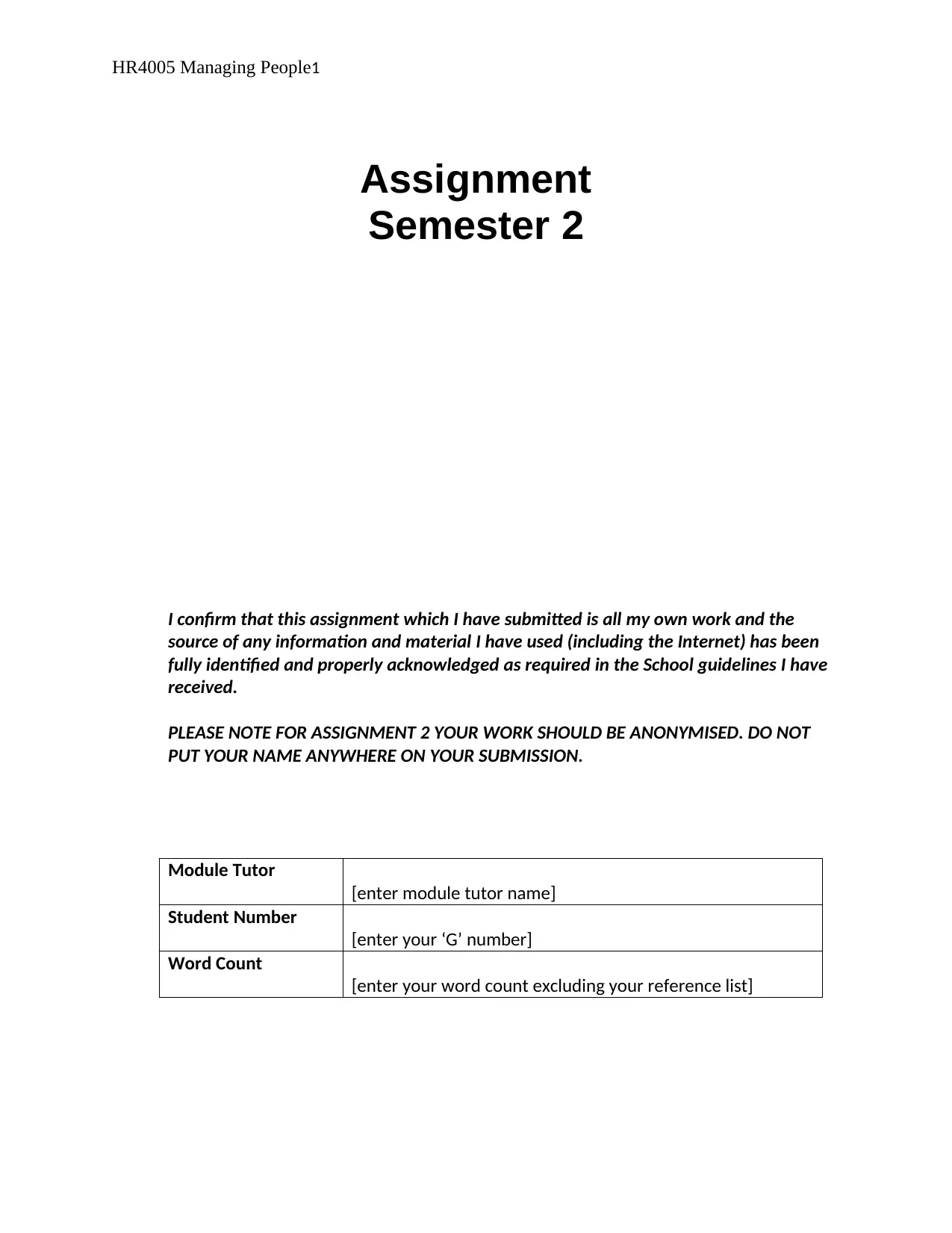
HR4005 Managing People1
Assignment
Semester 2
I confirm that this assignment which I have submitted is all my own work and the
source of any information and material I have used (including the Internet) has been
fully identified and properly acknowledged as required in the School guidelines I have
received.
PLEASE NOTE FOR ASSIGNMENT 2 YOUR WORK SHOULD BE ANONYMISED. DO NOT
PUT YOUR NAME ANYWHERE ON YOUR SUBMISSION.
Module Tutor
[enter module tutor name]
Student Number
[enter your ‘G’ number]
Word Count
[enter your word count excluding your reference list]
Assignment
Semester 2
I confirm that this assignment which I have submitted is all my own work and the
source of any information and material I have used (including the Internet) has been
fully identified and properly acknowledged as required in the School guidelines I have
received.
PLEASE NOTE FOR ASSIGNMENT 2 YOUR WORK SHOULD BE ANONYMISED. DO NOT
PUT YOUR NAME ANYWHERE ON YOUR SUBMISSION.
Module Tutor
[enter module tutor name]
Student Number
[enter your ‘G’ number]
Word Count
[enter your word count excluding your reference list]
Paraphrase This Document
Need a fresh take? Get an instant paraphrase of this document with our AI Paraphraser
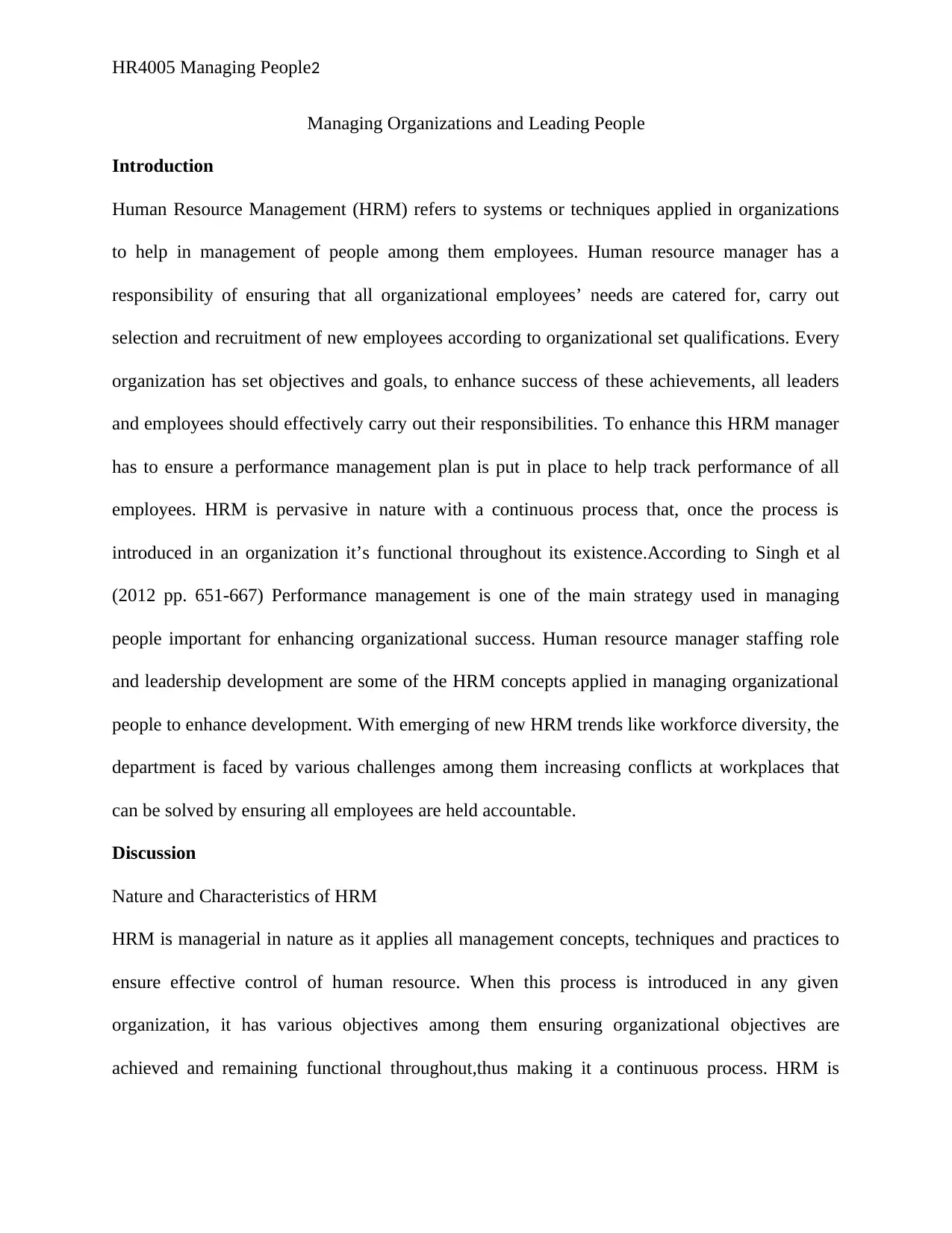
HR4005 Managing People2
Managing Organizations and Leading People
Introduction
Human Resource Management (HRM) refers to systems or techniques applied in organizations
to help in management of people among them employees. Human resource manager has a
responsibility of ensuring that all organizational employees’ needs are catered for, carry out
selection and recruitment of new employees according to organizational set qualifications. Every
organization has set objectives and goals, to enhance success of these achievements, all leaders
and employees should effectively carry out their responsibilities. To enhance this HRM manager
has to ensure a performance management plan is put in place to help track performance of all
employees. HRM is pervasive in nature with a continuous process that, once the process is
introduced in an organization it’s functional throughout its existence.According to Singh et al
(2012 pp. 651-667) Performance management is one of the main strategy used in managing
people important for enhancing organizational success. Human resource manager staffing role
and leadership development are some of the HRM concepts applied in managing organizational
people to enhance development. With emerging of new HRM trends like workforce diversity, the
department is faced by various challenges among them increasing conflicts at workplaces that
can be solved by ensuring all employees are held accountable.
Discussion
Nature and Characteristics of HRM
HRM is managerial in nature as it applies all management concepts, techniques and practices to
ensure effective control of human resource. When this process is introduced in any given
organization, it has various objectives among them ensuring organizational objectives are
achieved and remaining functional throughout,thus making it a continuous process. HRM is
Managing Organizations and Leading People
Introduction
Human Resource Management (HRM) refers to systems or techniques applied in organizations
to help in management of people among them employees. Human resource manager has a
responsibility of ensuring that all organizational employees’ needs are catered for, carry out
selection and recruitment of new employees according to organizational set qualifications. Every
organization has set objectives and goals, to enhance success of these achievements, all leaders
and employees should effectively carry out their responsibilities. To enhance this HRM manager
has to ensure a performance management plan is put in place to help track performance of all
employees. HRM is pervasive in nature with a continuous process that, once the process is
introduced in an organization it’s functional throughout its existence.According to Singh et al
(2012 pp. 651-667) Performance management is one of the main strategy used in managing
people important for enhancing organizational success. Human resource manager staffing role
and leadership development are some of the HRM concepts applied in managing organizational
people to enhance development. With emerging of new HRM trends like workforce diversity, the
department is faced by various challenges among them increasing conflicts at workplaces that
can be solved by ensuring all employees are held accountable.
Discussion
Nature and Characteristics of HRM
HRM is managerial in nature as it applies all management concepts, techniques and practices to
ensure effective control of human resource. When this process is introduced in any given
organization, it has various objectives among them ensuring organizational objectives are
achieved and remaining functional throughout,thus making it a continuous process. HRM is
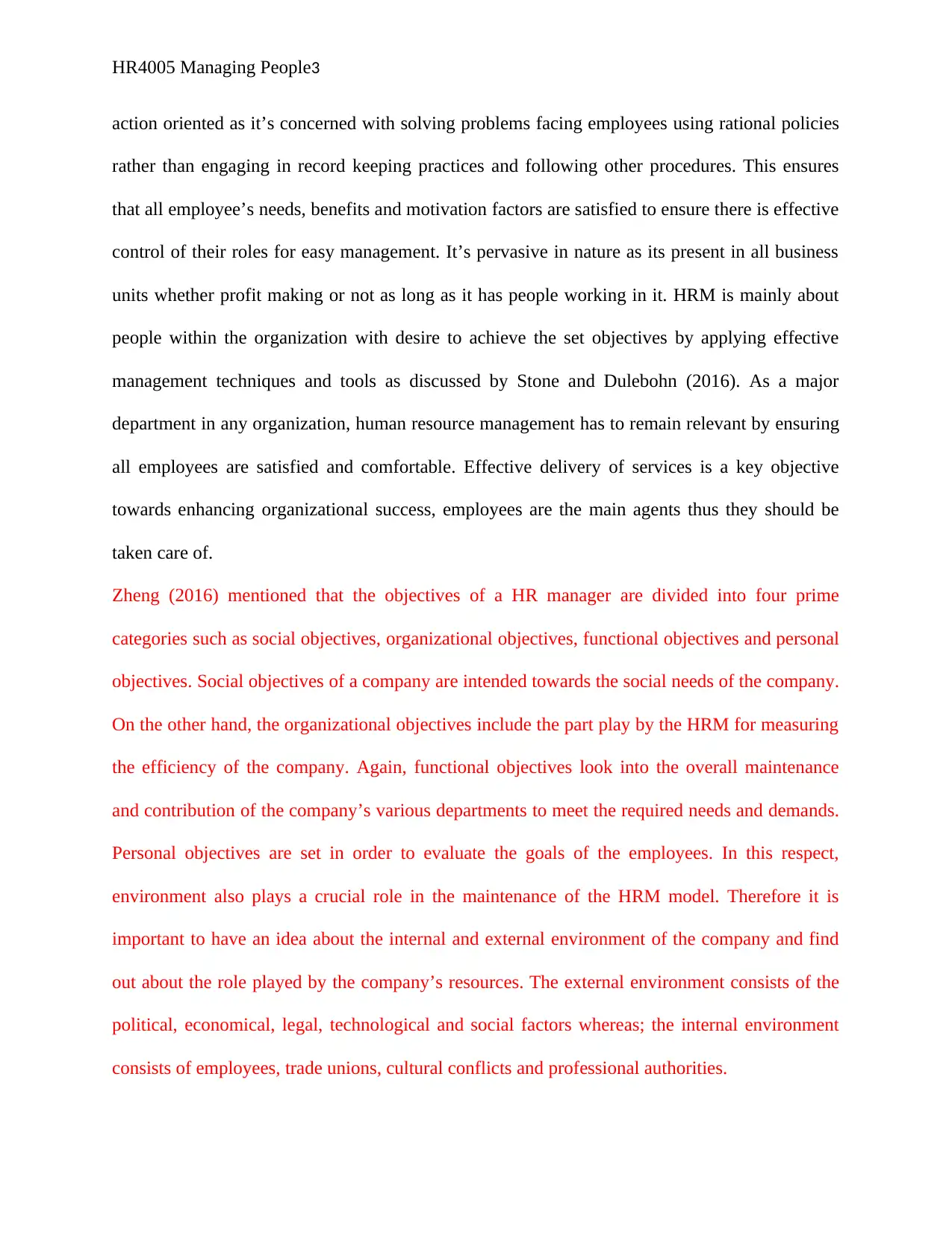
HR4005 Managing People3
action oriented as it’s concerned with solving problems facing employees using rational policies
rather than engaging in record keeping practices and following other procedures. This ensures
that all employee’s needs, benefits and motivation factors are satisfied to ensure there is effective
control of their roles for easy management. It’s pervasive in nature as its present in all business
units whether profit making or not as long as it has people working in it. HRM is mainly about
people within the organization with desire to achieve the set objectives by applying effective
management techniques and tools as discussed by Stone and Dulebohn (2016). As a major
department in any organization, human resource management has to remain relevant by ensuring
all employees are satisfied and comfortable. Effective delivery of services is a key objective
towards enhancing organizational success, employees are the main agents thus they should be
taken care of.
Zheng (2016) mentioned that the objectives of a HR manager are divided into four prime
categories such as social objectives, organizational objectives, functional objectives and personal
objectives. Social objectives of a company are intended towards the social needs of the company.
On the other hand, the organizational objectives include the part play by the HRM for measuring
the efficiency of the company. Again, functional objectives look into the overall maintenance
and contribution of the company’s various departments to meet the required needs and demands.
Personal objectives are set in order to evaluate the goals of the employees. In this respect,
environment also plays a crucial role in the maintenance of the HRM model. Therefore it is
important to have an idea about the internal and external environment of the company and find
out about the role played by the company’s resources. The external environment consists of the
political, economical, legal, technological and social factors whereas; the internal environment
consists of employees, trade unions, cultural conflicts and professional authorities.
action oriented as it’s concerned with solving problems facing employees using rational policies
rather than engaging in record keeping practices and following other procedures. This ensures
that all employee’s needs, benefits and motivation factors are satisfied to ensure there is effective
control of their roles for easy management. It’s pervasive in nature as its present in all business
units whether profit making or not as long as it has people working in it. HRM is mainly about
people within the organization with desire to achieve the set objectives by applying effective
management techniques and tools as discussed by Stone and Dulebohn (2016). As a major
department in any organization, human resource management has to remain relevant by ensuring
all employees are satisfied and comfortable. Effective delivery of services is a key objective
towards enhancing organizational success, employees are the main agents thus they should be
taken care of.
Zheng (2016) mentioned that the objectives of a HR manager are divided into four prime
categories such as social objectives, organizational objectives, functional objectives and personal
objectives. Social objectives of a company are intended towards the social needs of the company.
On the other hand, the organizational objectives include the part play by the HRM for measuring
the efficiency of the company. Again, functional objectives look into the overall maintenance
and contribution of the company’s various departments to meet the required needs and demands.
Personal objectives are set in order to evaluate the goals of the employees. In this respect,
environment also plays a crucial role in the maintenance of the HRM model. Therefore it is
important to have an idea about the internal and external environment of the company and find
out about the role played by the company’s resources. The external environment consists of the
political, economical, legal, technological and social factors whereas; the internal environment
consists of employees, trade unions, cultural conflicts and professional authorities.
⊘ This is a preview!⊘
Do you want full access?
Subscribe today to unlock all pages.

Trusted by 1+ million students worldwide
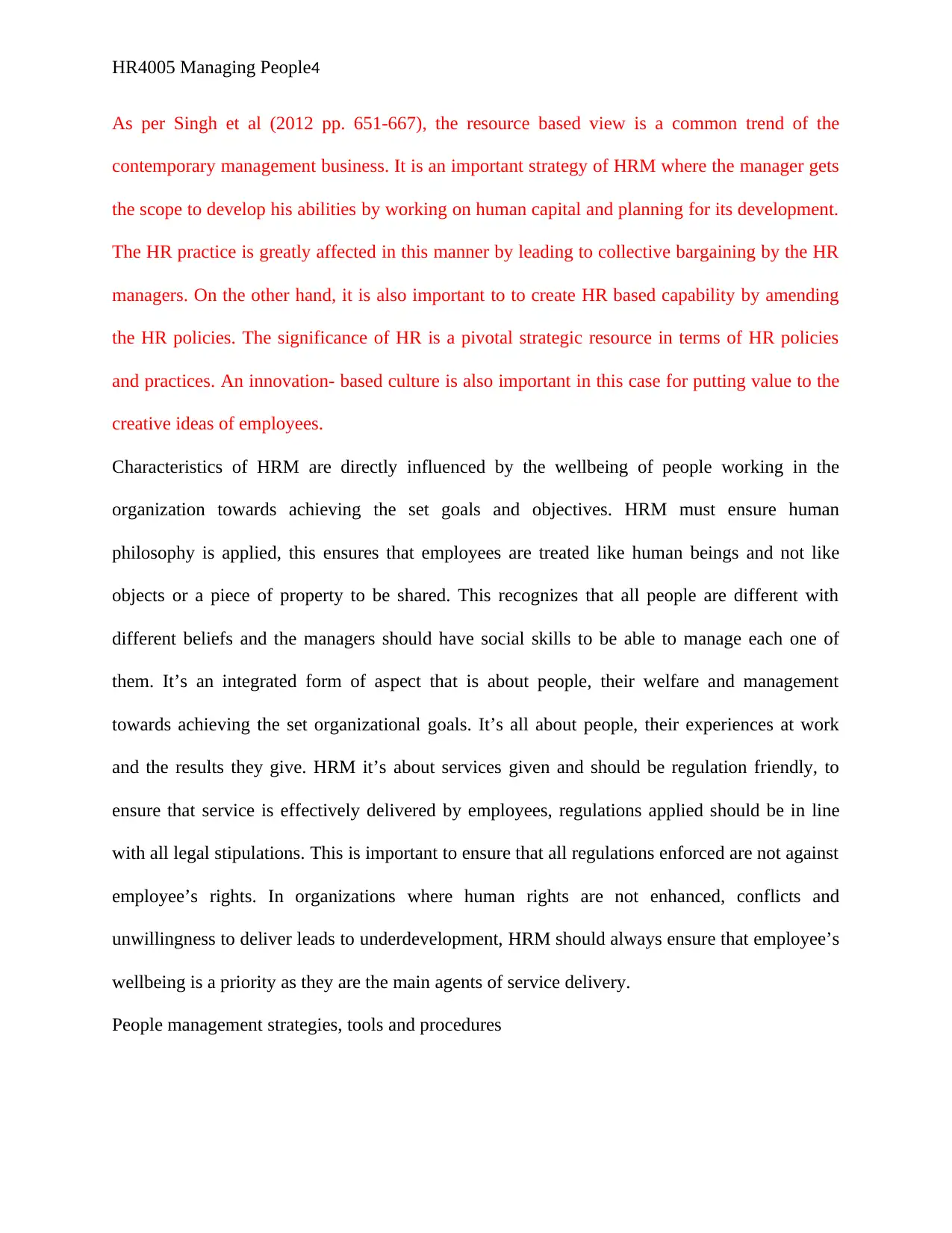
HR4005 Managing People4
As per Singh et al (2012 pp. 651-667), the resource based view is a common trend of the
contemporary management business. It is an important strategy of HRM where the manager gets
the scope to develop his abilities by working on human capital and planning for its development.
The HR practice is greatly affected in this manner by leading to collective bargaining by the HR
managers. On the other hand, it is also important to to create HR based capability by amending
the HR policies. The significance of HR is a pivotal strategic resource in terms of HR policies
and practices. An innovation- based culture is also important in this case for putting value to the
creative ideas of employees.
Characteristics of HRM are directly influenced by the wellbeing of people working in the
organization towards achieving the set goals and objectives. HRM must ensure human
philosophy is applied, this ensures that employees are treated like human beings and not like
objects or a piece of property to be shared. This recognizes that all people are different with
different beliefs and the managers should have social skills to be able to manage each one of
them. It’s an integrated form of aspect that is about people, their welfare and management
towards achieving the set organizational goals. It’s all about people, their experiences at work
and the results they give. HRM it’s about services given and should be regulation friendly, to
ensure that service is effectively delivered by employees, regulations applied should be in line
with all legal stipulations. This is important to ensure that all regulations enforced are not against
employee’s rights. In organizations where human rights are not enhanced, conflicts and
unwillingness to deliver leads to underdevelopment, HRM should always ensure that employee’s
wellbeing is a priority as they are the main agents of service delivery.
People management strategies, tools and procedures
As per Singh et al (2012 pp. 651-667), the resource based view is a common trend of the
contemporary management business. It is an important strategy of HRM where the manager gets
the scope to develop his abilities by working on human capital and planning for its development.
The HR practice is greatly affected in this manner by leading to collective bargaining by the HR
managers. On the other hand, it is also important to to create HR based capability by amending
the HR policies. The significance of HR is a pivotal strategic resource in terms of HR policies
and practices. An innovation- based culture is also important in this case for putting value to the
creative ideas of employees.
Characteristics of HRM are directly influenced by the wellbeing of people working in the
organization towards achieving the set goals and objectives. HRM must ensure human
philosophy is applied, this ensures that employees are treated like human beings and not like
objects or a piece of property to be shared. This recognizes that all people are different with
different beliefs and the managers should have social skills to be able to manage each one of
them. It’s an integrated form of aspect that is about people, their welfare and management
towards achieving the set organizational goals. It’s all about people, their experiences at work
and the results they give. HRM it’s about services given and should be regulation friendly, to
ensure that service is effectively delivered by employees, regulations applied should be in line
with all legal stipulations. This is important to ensure that all regulations enforced are not against
employee’s rights. In organizations where human rights are not enhanced, conflicts and
unwillingness to deliver leads to underdevelopment, HRM should always ensure that employee’s
wellbeing is a priority as they are the main agents of service delivery.
People management strategies, tools and procedures
Paraphrase This Document
Need a fresh take? Get an instant paraphrase of this document with our AI Paraphraser
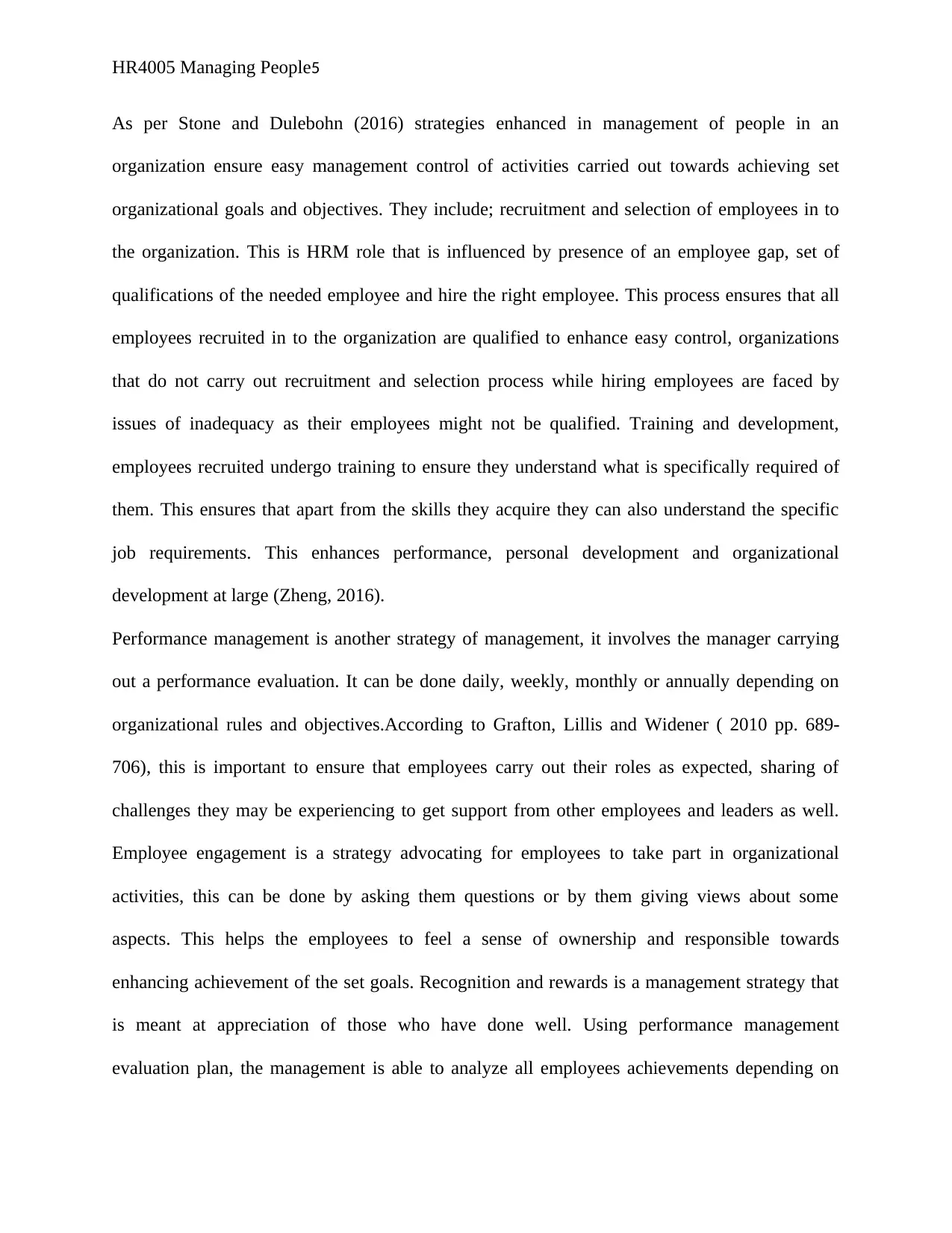
HR4005 Managing People5
As per Stone and Dulebohn (2016) strategies enhanced in management of people in an
organization ensure easy management control of activities carried out towards achieving set
organizational goals and objectives. They include; recruitment and selection of employees in to
the organization. This is HRM role that is influenced by presence of an employee gap, set of
qualifications of the needed employee and hire the right employee. This process ensures that all
employees recruited in to the organization are qualified to enhance easy control, organizations
that do not carry out recruitment and selection process while hiring employees are faced by
issues of inadequacy as their employees might not be qualified. Training and development,
employees recruited undergo training to ensure they understand what is specifically required of
them. This ensures that apart from the skills they acquire they can also understand the specific
job requirements. This enhances performance, personal development and organizational
development at large (Zheng, 2016).
Performance management is another strategy of management, it involves the manager carrying
out a performance evaluation. It can be done daily, weekly, monthly or annually depending on
organizational rules and objectives.According to Grafton, Lillis and Widener ( 2010 pp. 689-
706), this is important to ensure that employees carry out their roles as expected, sharing of
challenges they may be experiencing to get support from other employees and leaders as well.
Employee engagement is a strategy advocating for employees to take part in organizational
activities, this can be done by asking them questions or by them giving views about some
aspects. This helps the employees to feel a sense of ownership and responsible towards
enhancing achievement of the set goals. Recognition and rewards is a management strategy that
is meant at appreciation of those who have done well. Using performance management
evaluation plan, the management is able to analyze all employees achievements depending on
As per Stone and Dulebohn (2016) strategies enhanced in management of people in an
organization ensure easy management control of activities carried out towards achieving set
organizational goals and objectives. They include; recruitment and selection of employees in to
the organization. This is HRM role that is influenced by presence of an employee gap, set of
qualifications of the needed employee and hire the right employee. This process ensures that all
employees recruited in to the organization are qualified to enhance easy control, organizations
that do not carry out recruitment and selection process while hiring employees are faced by
issues of inadequacy as their employees might not be qualified. Training and development,
employees recruited undergo training to ensure they understand what is specifically required of
them. This ensures that apart from the skills they acquire they can also understand the specific
job requirements. This enhances performance, personal development and organizational
development at large (Zheng, 2016).
Performance management is another strategy of management, it involves the manager carrying
out a performance evaluation. It can be done daily, weekly, monthly or annually depending on
organizational rules and objectives.According to Grafton, Lillis and Widener ( 2010 pp. 689-
706), this is important to ensure that employees carry out their roles as expected, sharing of
challenges they may be experiencing to get support from other employees and leaders as well.
Employee engagement is a strategy advocating for employees to take part in organizational
activities, this can be done by asking them questions or by them giving views about some
aspects. This helps the employees to feel a sense of ownership and responsible towards
enhancing achievement of the set goals. Recognition and rewards is a management strategy that
is meant at appreciation of those who have done well. Using performance management
evaluation plan, the management is able to analyze all employees achievements depending on
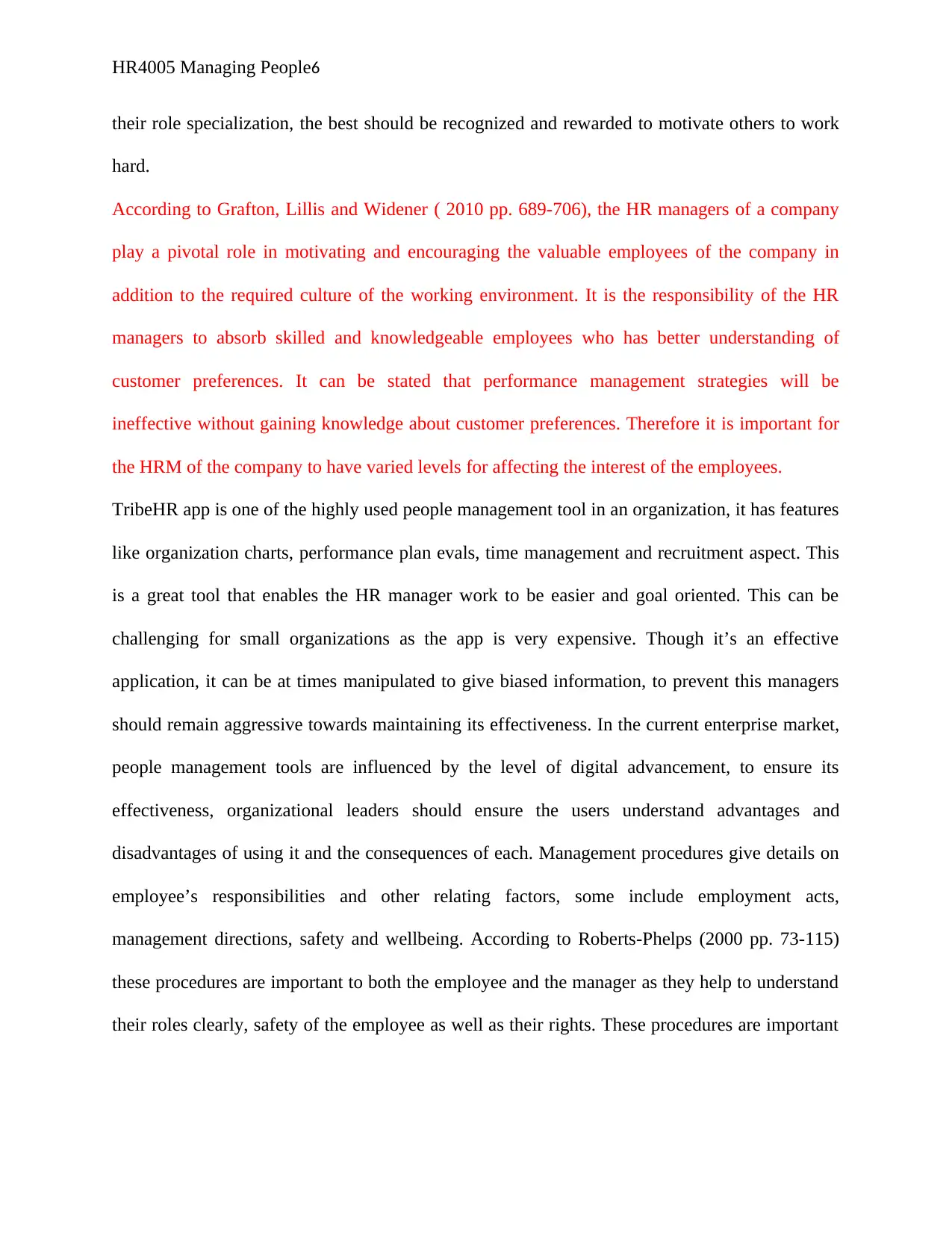
HR4005 Managing People6
their role specialization, the best should be recognized and rewarded to motivate others to work
hard.
According to Grafton, Lillis and Widener ( 2010 pp. 689-706), the HR managers of a company
play a pivotal role in motivating and encouraging the valuable employees of the company in
addition to the required culture of the working environment. It is the responsibility of the HR
managers to absorb skilled and knowledgeable employees who has better understanding of
customer preferences. It can be stated that performance management strategies will be
ineffective without gaining knowledge about customer preferences. Therefore it is important for
the HRM of the company to have varied levels for affecting the interest of the employees.
TribeHR app is one of the highly used people management tool in an organization, it has features
like organization charts, performance plan evals, time management and recruitment aspect. This
is a great tool that enables the HR manager work to be easier and goal oriented. This can be
challenging for small organizations as the app is very expensive. Though it’s an effective
application, it can be at times manipulated to give biased information, to prevent this managers
should remain aggressive towards maintaining its effectiveness. In the current enterprise market,
people management tools are influenced by the level of digital advancement, to ensure its
effectiveness, organizational leaders should ensure the users understand advantages and
disadvantages of using it and the consequences of each. Management procedures give details on
employee’s responsibilities and other relating factors, some include employment acts,
management directions, safety and wellbeing. According to Roberts-Phelps (2000 pp. 73-115)
these procedures are important to both the employee and the manager as they help to understand
their roles clearly, safety of the employee as well as their rights. These procedures are important
their role specialization, the best should be recognized and rewarded to motivate others to work
hard.
According to Grafton, Lillis and Widener ( 2010 pp. 689-706), the HR managers of a company
play a pivotal role in motivating and encouraging the valuable employees of the company in
addition to the required culture of the working environment. It is the responsibility of the HR
managers to absorb skilled and knowledgeable employees who has better understanding of
customer preferences. It can be stated that performance management strategies will be
ineffective without gaining knowledge about customer preferences. Therefore it is important for
the HRM of the company to have varied levels for affecting the interest of the employees.
TribeHR app is one of the highly used people management tool in an organization, it has features
like organization charts, performance plan evals, time management and recruitment aspect. This
is a great tool that enables the HR manager work to be easier and goal oriented. This can be
challenging for small organizations as the app is very expensive. Though it’s an effective
application, it can be at times manipulated to give biased information, to prevent this managers
should remain aggressive towards maintaining its effectiveness. In the current enterprise market,
people management tools are influenced by the level of digital advancement, to ensure its
effectiveness, organizational leaders should ensure the users understand advantages and
disadvantages of using it and the consequences of each. Management procedures give details on
employee’s responsibilities and other relating factors, some include employment acts,
management directions, safety and wellbeing. According to Roberts-Phelps (2000 pp. 73-115)
these procedures are important to both the employee and the manager as they help to understand
their roles clearly, safety of the employee as well as their rights. These procedures are important
⊘ This is a preview!⊘
Do you want full access?
Subscribe today to unlock all pages.

Trusted by 1+ million students worldwide
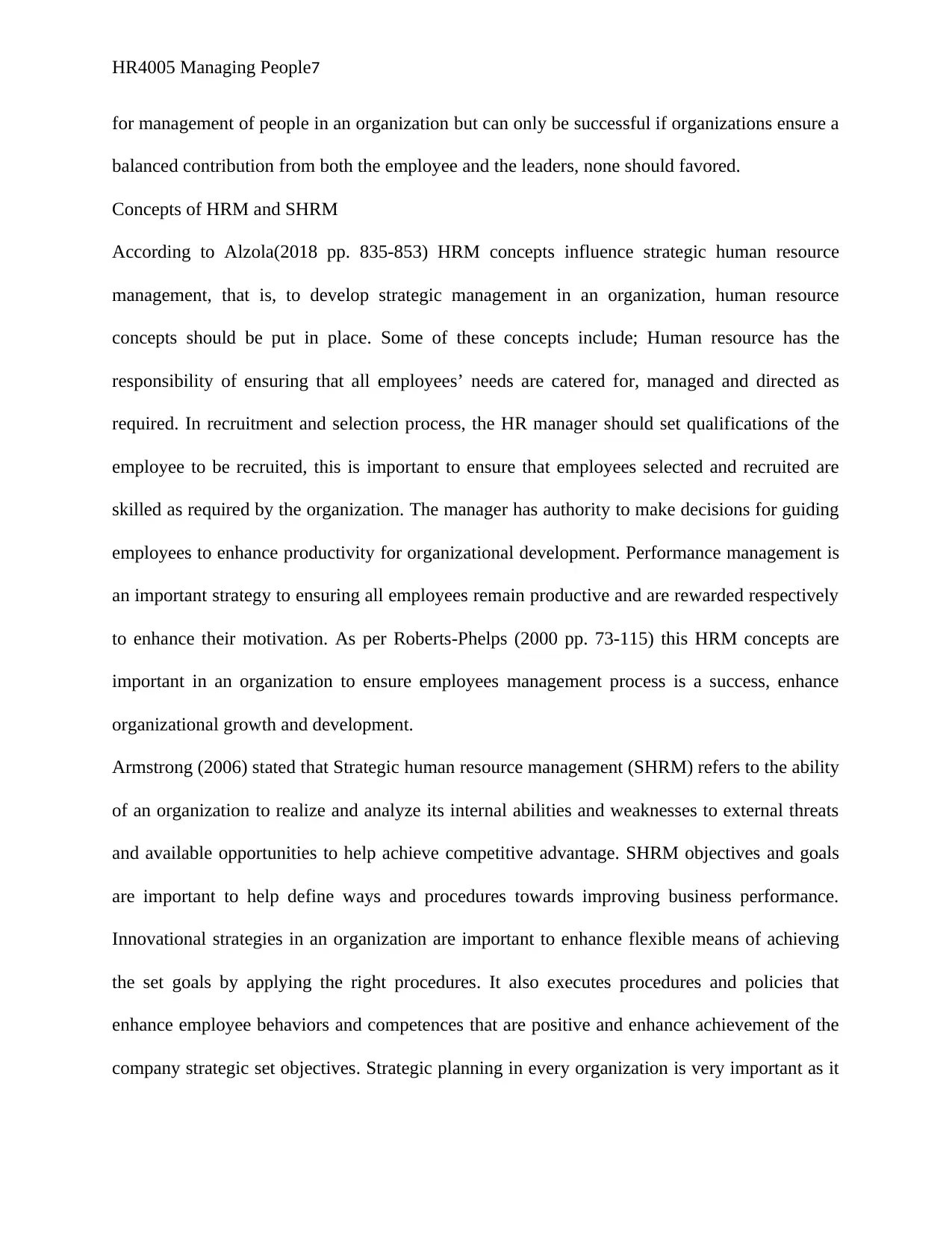
HR4005 Managing People7
for management of people in an organization but can only be successful if organizations ensure a
balanced contribution from both the employee and the leaders, none should favored.
Concepts of HRM and SHRM
According to Alzola(2018 pp. 835-853) HRM concepts influence strategic human resource
management, that is, to develop strategic management in an organization, human resource
concepts should be put in place. Some of these concepts include; Human resource has the
responsibility of ensuring that all employees’ needs are catered for, managed and directed as
required. In recruitment and selection process, the HR manager should set qualifications of the
employee to be recruited, this is important to ensure that employees selected and recruited are
skilled as required by the organization. The manager has authority to make decisions for guiding
employees to enhance productivity for organizational development. Performance management is
an important strategy to ensuring all employees remain productive and are rewarded respectively
to enhance their motivation. As per Roberts-Phelps (2000 pp. 73-115) this HRM concepts are
important in an organization to ensure employees management process is a success, enhance
organizational growth and development.
Armstrong (2006) stated that Strategic human resource management (SHRM) refers to the ability
of an organization to realize and analyze its internal abilities and weaknesses to external threats
and available opportunities to help achieve competitive advantage. SHRM objectives and goals
are important to help define ways and procedures towards improving business performance.
Innovational strategies in an organization are important to enhance flexible means of achieving
the set goals by applying the right procedures. It also executes procedures and policies that
enhance employee behaviors and competences that are positive and enhance achievement of the
company strategic set objectives. Strategic planning in every organization is very important as it
for management of people in an organization but can only be successful if organizations ensure a
balanced contribution from both the employee and the leaders, none should favored.
Concepts of HRM and SHRM
According to Alzola(2018 pp. 835-853) HRM concepts influence strategic human resource
management, that is, to develop strategic management in an organization, human resource
concepts should be put in place. Some of these concepts include; Human resource has the
responsibility of ensuring that all employees’ needs are catered for, managed and directed as
required. In recruitment and selection process, the HR manager should set qualifications of the
employee to be recruited, this is important to ensure that employees selected and recruited are
skilled as required by the organization. The manager has authority to make decisions for guiding
employees to enhance productivity for organizational development. Performance management is
an important strategy to ensuring all employees remain productive and are rewarded respectively
to enhance their motivation. As per Roberts-Phelps (2000 pp. 73-115) this HRM concepts are
important in an organization to ensure employees management process is a success, enhance
organizational growth and development.
Armstrong (2006) stated that Strategic human resource management (SHRM) refers to the ability
of an organization to realize and analyze its internal abilities and weaknesses to external threats
and available opportunities to help achieve competitive advantage. SHRM objectives and goals
are important to help define ways and procedures towards improving business performance.
Innovational strategies in an organization are important to enhance flexible means of achieving
the set goals by applying the right procedures. It also executes procedures and policies that
enhance employee behaviors and competences that are positive and enhance achievement of the
company strategic set objectives. Strategic planning in every organization is very important as it
Paraphrase This Document
Need a fresh take? Get an instant paraphrase of this document with our AI Paraphraser
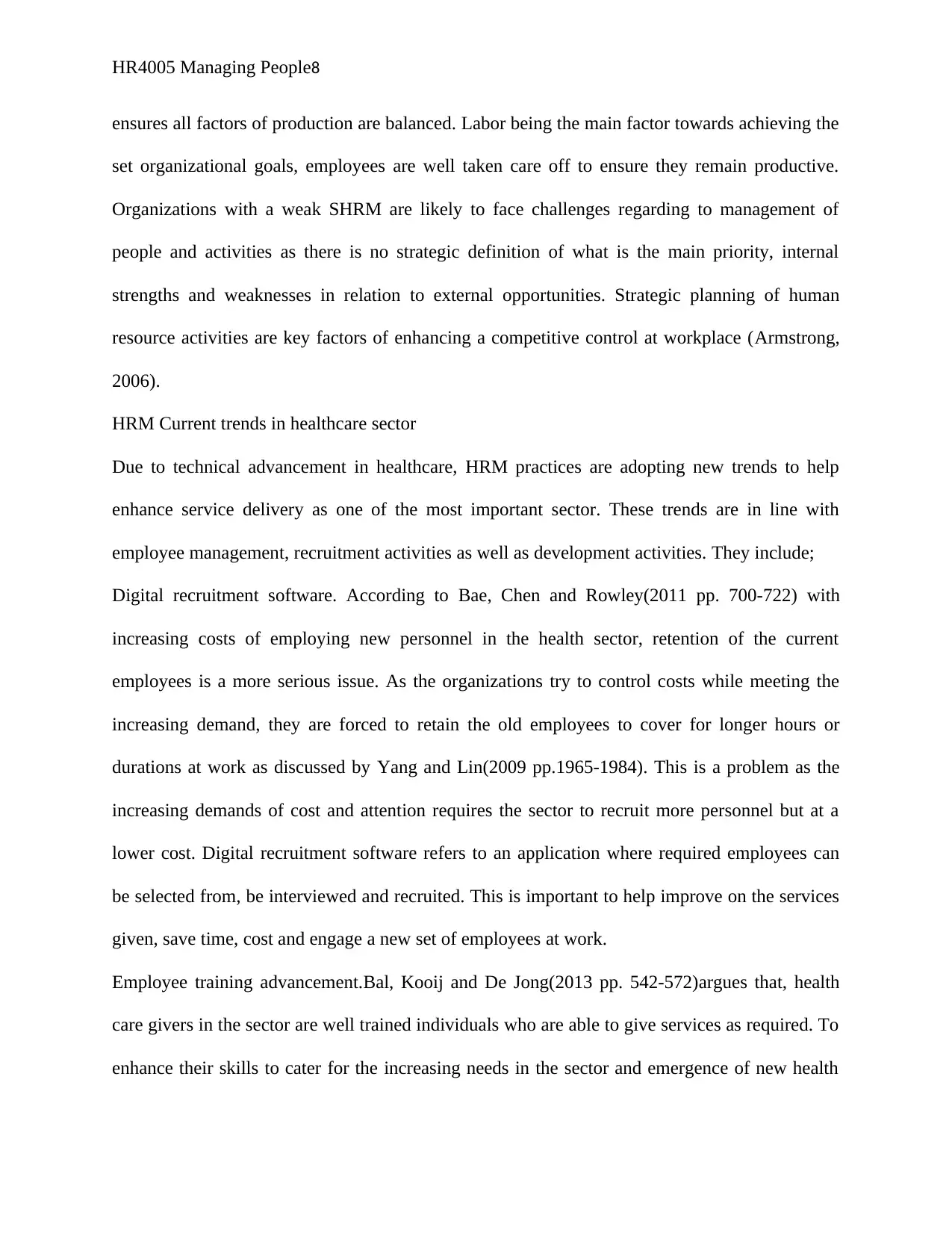
HR4005 Managing People8
ensures all factors of production are balanced. Labor being the main factor towards achieving the
set organizational goals, employees are well taken care off to ensure they remain productive.
Organizations with a weak SHRM are likely to face challenges regarding to management of
people and activities as there is no strategic definition of what is the main priority, internal
strengths and weaknesses in relation to external opportunities. Strategic planning of human
resource activities are key factors of enhancing a competitive control at workplace (Armstrong,
2006).
HRM Current trends in healthcare sector
Due to technical advancement in healthcare, HRM practices are adopting new trends to help
enhance service delivery as one of the most important sector. These trends are in line with
employee management, recruitment activities as well as development activities. They include;
Digital recruitment software. According to Bae, Chen and Rowley(2011 pp. 700-722) with
increasing costs of employing new personnel in the health sector, retention of the current
employees is a more serious issue. As the organizations try to control costs while meeting the
increasing demand, they are forced to retain the old employees to cover for longer hours or
durations at work as discussed by Yang and Lin(2009 pp.1965-1984). This is a problem as the
increasing demands of cost and attention requires the sector to recruit more personnel but at a
lower cost. Digital recruitment software refers to an application where required employees can
be selected from, be interviewed and recruited. This is important to help improve on the services
given, save time, cost and engage a new set of employees at work.
Employee training advancement.Bal, Kooij and De Jong(2013 pp. 542-572)argues that, health
care givers in the sector are well trained individuals who are able to give services as required. To
enhance their skills to cater for the increasing needs in the sector and emergence of new health
ensures all factors of production are balanced. Labor being the main factor towards achieving the
set organizational goals, employees are well taken care off to ensure they remain productive.
Organizations with a weak SHRM are likely to face challenges regarding to management of
people and activities as there is no strategic definition of what is the main priority, internal
strengths and weaknesses in relation to external opportunities. Strategic planning of human
resource activities are key factors of enhancing a competitive control at workplace (Armstrong,
2006).
HRM Current trends in healthcare sector
Due to technical advancement in healthcare, HRM practices are adopting new trends to help
enhance service delivery as one of the most important sector. These trends are in line with
employee management, recruitment activities as well as development activities. They include;
Digital recruitment software. According to Bae, Chen and Rowley(2011 pp. 700-722) with
increasing costs of employing new personnel in the health sector, retention of the current
employees is a more serious issue. As the organizations try to control costs while meeting the
increasing demand, they are forced to retain the old employees to cover for longer hours or
durations at work as discussed by Yang and Lin(2009 pp.1965-1984). This is a problem as the
increasing demands of cost and attention requires the sector to recruit more personnel but at a
lower cost. Digital recruitment software refers to an application where required employees can
be selected from, be interviewed and recruited. This is important to help improve on the services
given, save time, cost and engage a new set of employees at work.
Employee training advancement.Bal, Kooij and De Jong(2013 pp. 542-572)argues that, health
care givers in the sector are well trained individuals who are able to give services as required. To
enhance their skills to cater for the increasing needs in the sector and emergence of new health
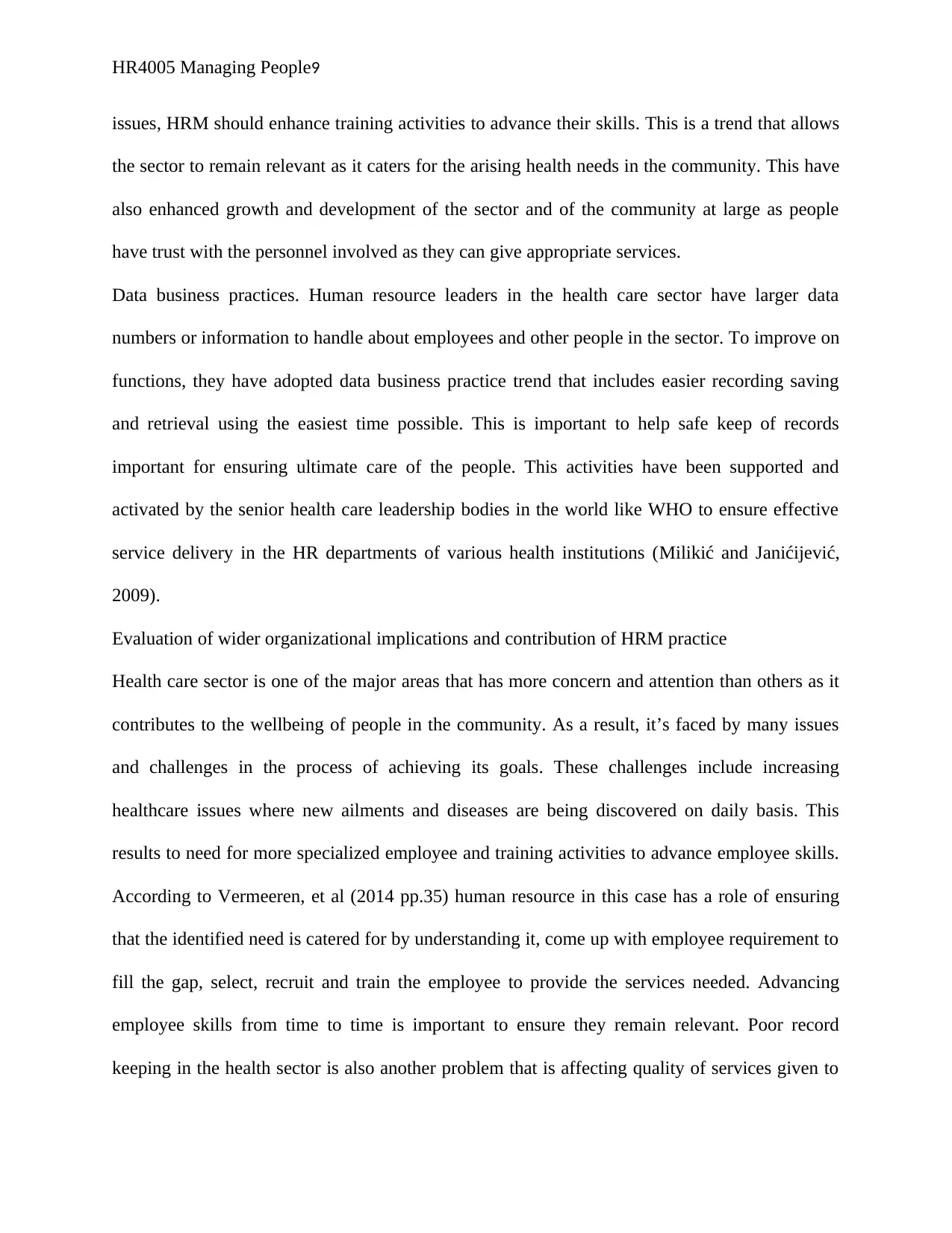
HR4005 Managing People9
issues, HRM should enhance training activities to advance their skills. This is a trend that allows
the sector to remain relevant as it caters for the arising health needs in the community. This have
also enhanced growth and development of the sector and of the community at large as people
have trust with the personnel involved as they can give appropriate services.
Data business practices. Human resource leaders in the health care sector have larger data
numbers or information to handle about employees and other people in the sector. To improve on
functions, they have adopted data business practice trend that includes easier recording saving
and retrieval using the easiest time possible. This is important to help safe keep of records
important for ensuring ultimate care of the people. This activities have been supported and
activated by the senior health care leadership bodies in the world like WHO to ensure effective
service delivery in the HR departments of various health institutions (Milikić and Janićijević,
2009).
Evaluation of wider organizational implications and contribution of HRM practice
Health care sector is one of the major areas that has more concern and attention than others as it
contributes to the wellbeing of people in the community. As a result, it’s faced by many issues
and challenges in the process of achieving its goals. These challenges include increasing
healthcare issues where new ailments and diseases are being discovered on daily basis. This
results to need for more specialized employee and training activities to advance employee skills.
According to Vermeeren, et al (2014 pp.35) human resource in this case has a role of ensuring
that the identified need is catered for by understanding it, come up with employee requirement to
fill the gap, select, recruit and train the employee to provide the services needed. Advancing
employee skills from time to time is important to ensure they remain relevant. Poor record
keeping in the health sector is also another problem that is affecting quality of services given to
issues, HRM should enhance training activities to advance their skills. This is a trend that allows
the sector to remain relevant as it caters for the arising health needs in the community. This have
also enhanced growth and development of the sector and of the community at large as people
have trust with the personnel involved as they can give appropriate services.
Data business practices. Human resource leaders in the health care sector have larger data
numbers or information to handle about employees and other people in the sector. To improve on
functions, they have adopted data business practice trend that includes easier recording saving
and retrieval using the easiest time possible. This is important to help safe keep of records
important for ensuring ultimate care of the people. This activities have been supported and
activated by the senior health care leadership bodies in the world like WHO to ensure effective
service delivery in the HR departments of various health institutions (Milikić and Janićijević,
2009).
Evaluation of wider organizational implications and contribution of HRM practice
Health care sector is one of the major areas that has more concern and attention than others as it
contributes to the wellbeing of people in the community. As a result, it’s faced by many issues
and challenges in the process of achieving its goals. These challenges include increasing
healthcare issues where new ailments and diseases are being discovered on daily basis. This
results to need for more specialized employee and training activities to advance employee skills.
According to Vermeeren, et al (2014 pp.35) human resource in this case has a role of ensuring
that the identified need is catered for by understanding it, come up with employee requirement to
fill the gap, select, recruit and train the employee to provide the services needed. Advancing
employee skills from time to time is important to ensure they remain relevant. Poor record
keeping in the health sector is also another problem that is affecting quality of services given to
⊘ This is a preview!⊘
Do you want full access?
Subscribe today to unlock all pages.

Trusted by 1+ million students worldwide
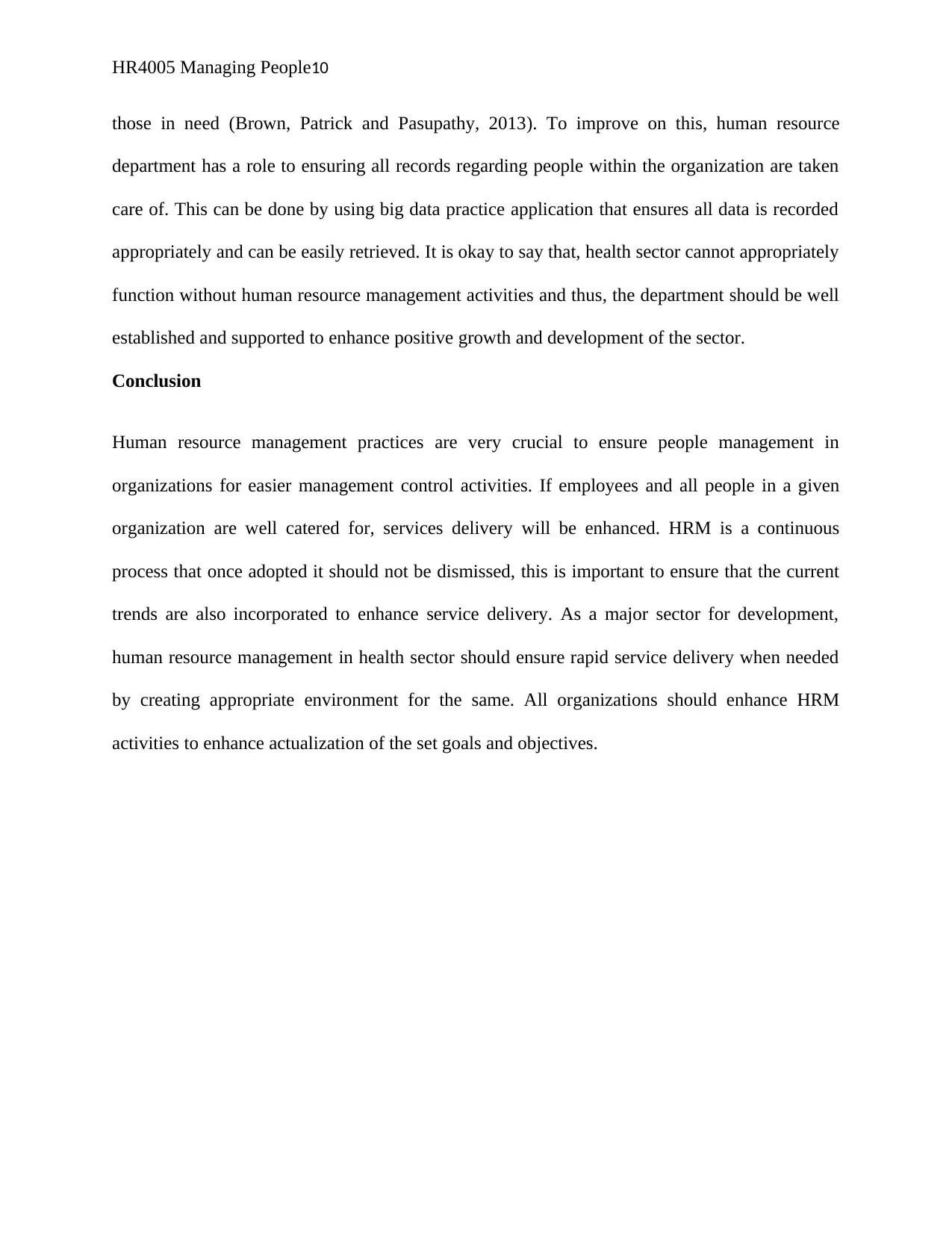
HR4005 Managing People10
those in need (Brown, Patrick and Pasupathy, 2013). To improve on this, human resource
department has a role to ensuring all records regarding people within the organization are taken
care of. This can be done by using big data practice application that ensures all data is recorded
appropriately and can be easily retrieved. It is okay to say that, health sector cannot appropriately
function without human resource management activities and thus, the department should be well
established and supported to enhance positive growth and development of the sector.
Conclusion
Human resource management practices are very crucial to ensure people management in
organizations for easier management control activities. If employees and all people in a given
organization are well catered for, services delivery will be enhanced. HRM is a continuous
process that once adopted it should not be dismissed, this is important to ensure that the current
trends are also incorporated to enhance service delivery. As a major sector for development,
human resource management in health sector should ensure rapid service delivery when needed
by creating appropriate environment for the same. All organizations should enhance HRM
activities to enhance actualization of the set goals and objectives.
those in need (Brown, Patrick and Pasupathy, 2013). To improve on this, human resource
department has a role to ensuring all records regarding people within the organization are taken
care of. This can be done by using big data practice application that ensures all data is recorded
appropriately and can be easily retrieved. It is okay to say that, health sector cannot appropriately
function without human resource management activities and thus, the department should be well
established and supported to enhance positive growth and development of the sector.
Conclusion
Human resource management practices are very crucial to ensure people management in
organizations for easier management control activities. If employees and all people in a given
organization are well catered for, services delivery will be enhanced. HRM is a continuous
process that once adopted it should not be dismissed, this is important to ensure that the current
trends are also incorporated to enhance service delivery. As a major sector for development,
human resource management in health sector should ensure rapid service delivery when needed
by creating appropriate environment for the same. All organizations should enhance HRM
activities to enhance actualization of the set goals and objectives.
Paraphrase This Document
Need a fresh take? Get an instant paraphrase of this document with our AI Paraphraser
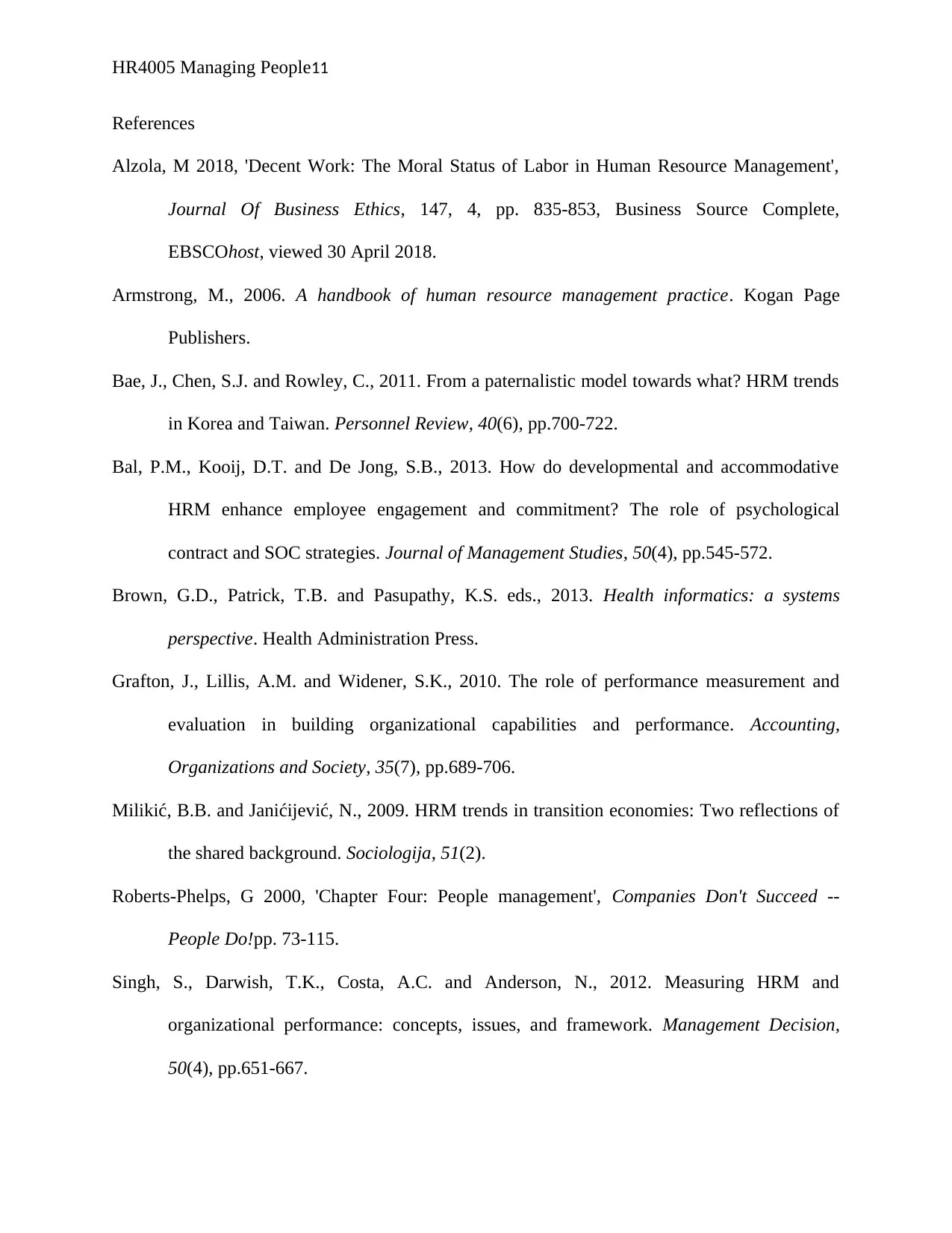
HR4005 Managing People11
References
Alzola, M 2018, 'Decent Work: The Moral Status of Labor in Human Resource Management',
Journal Of Business Ethics, 147, 4, pp. 835-853, Business Source Complete,
EBSCOhost, viewed 30 April 2018.
Armstrong, M., 2006. A handbook of human resource management practice. Kogan Page
Publishers.
Bae, J., Chen, S.J. and Rowley, C., 2011. From a paternalistic model towards what? HRM trends
in Korea and Taiwan. Personnel Review, 40(6), pp.700-722.
Bal, P.M., Kooij, D.T. and De Jong, S.B., 2013. How do developmental and accommodative
HRM enhance employee engagement and commitment? The role of psychological
contract and SOC strategies. Journal of Management Studies, 50(4), pp.545-572.
Brown, G.D., Patrick, T.B. and Pasupathy, K.S. eds., 2013. Health informatics: a systems
perspective. Health Administration Press.
Grafton, J., Lillis, A.M. and Widener, S.K., 2010. The role of performance measurement and
evaluation in building organizational capabilities and performance. Accounting,
Organizations and Society, 35(7), pp.689-706.
Milikić, B.B. and Janićijević, N., 2009. HRM trends in transition economies: Two reflections of
the shared background. Sociologija, 51(2).
Roberts-Phelps, G 2000, 'Chapter Four: People management', Companies Don't Succeed --
People Do!pp. 73-115.
Singh, S., Darwish, T.K., Costa, A.C. and Anderson, N., 2012. Measuring HRM and
organizational performance: concepts, issues, and framework. Management Decision,
50(4), pp.651-667.
References
Alzola, M 2018, 'Decent Work: The Moral Status of Labor in Human Resource Management',
Journal Of Business Ethics, 147, 4, pp. 835-853, Business Source Complete,
EBSCOhost, viewed 30 April 2018.
Armstrong, M., 2006. A handbook of human resource management practice. Kogan Page
Publishers.
Bae, J., Chen, S.J. and Rowley, C., 2011. From a paternalistic model towards what? HRM trends
in Korea and Taiwan. Personnel Review, 40(6), pp.700-722.
Bal, P.M., Kooij, D.T. and De Jong, S.B., 2013. How do developmental and accommodative
HRM enhance employee engagement and commitment? The role of psychological
contract and SOC strategies. Journal of Management Studies, 50(4), pp.545-572.
Brown, G.D., Patrick, T.B. and Pasupathy, K.S. eds., 2013. Health informatics: a systems
perspective. Health Administration Press.
Grafton, J., Lillis, A.M. and Widener, S.K., 2010. The role of performance measurement and
evaluation in building organizational capabilities and performance. Accounting,
Organizations and Society, 35(7), pp.689-706.
Milikić, B.B. and Janićijević, N., 2009. HRM trends in transition economies: Two reflections of
the shared background. Sociologija, 51(2).
Roberts-Phelps, G 2000, 'Chapter Four: People management', Companies Don't Succeed --
People Do!pp. 73-115.
Singh, S., Darwish, T.K., Costa, A.C. and Anderson, N., 2012. Measuring HRM and
organizational performance: concepts, issues, and framework. Management Decision,
50(4), pp.651-667.
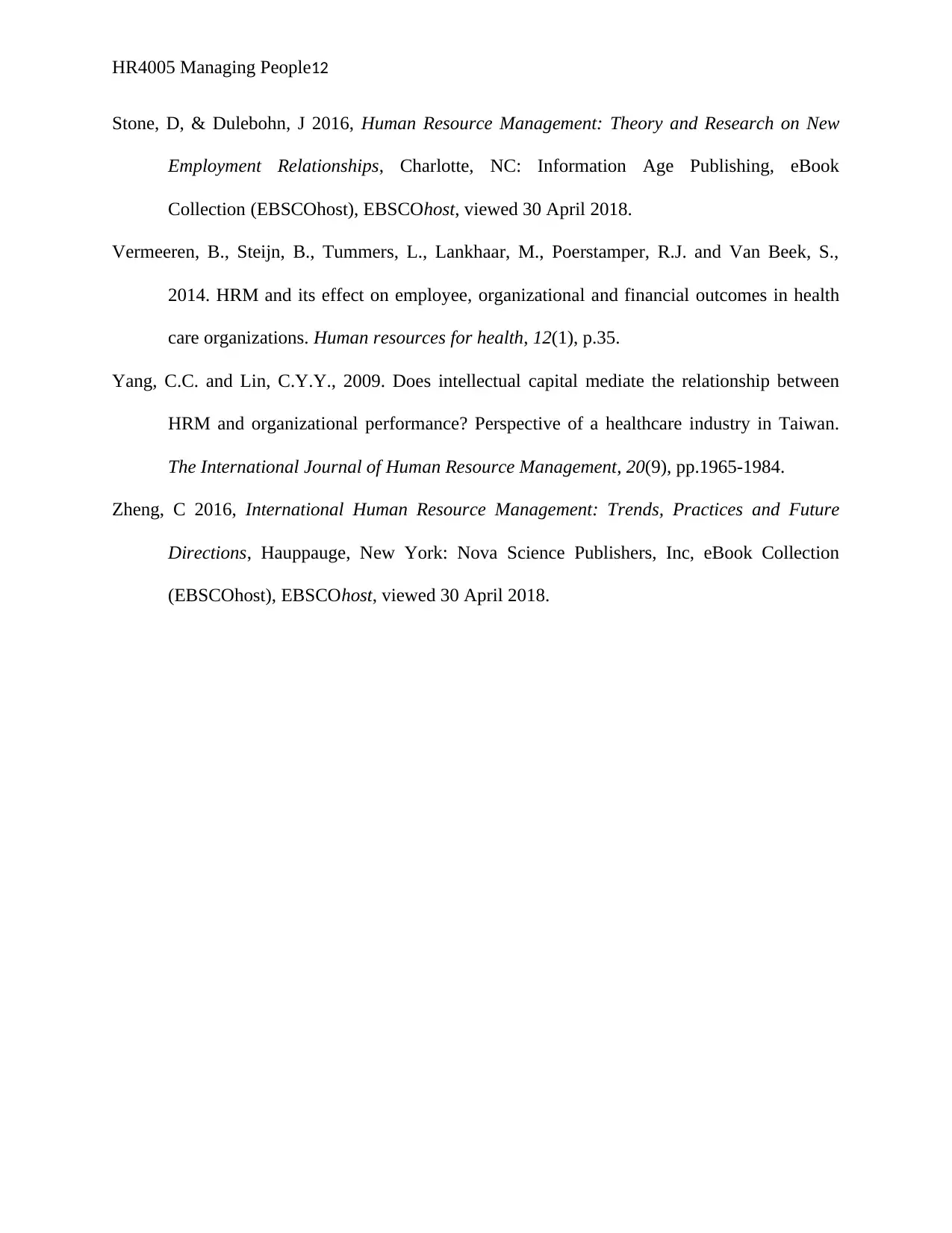
HR4005 Managing People12
Stone, D, & Dulebohn, J 2016, Human Resource Management: Theory and Research on New
Employment Relationships, Charlotte, NC: Information Age Publishing, eBook
Collection (EBSCOhost), EBSCOhost, viewed 30 April 2018.
Vermeeren, B., Steijn, B., Tummers, L., Lankhaar, M., Poerstamper, R.J. and Van Beek, S.,
2014. HRM and its effect on employee, organizational and financial outcomes in health
care organizations. Human resources for health, 12(1), p.35.
Yang, C.C. and Lin, C.Y.Y., 2009. Does intellectual capital mediate the relationship between
HRM and organizational performance? Perspective of a healthcare industry in Taiwan.
The International Journal of Human Resource Management, 20(9), pp.1965-1984.
Zheng, C 2016, International Human Resource Management: Trends, Practices and Future
Directions, Hauppauge, New York: Nova Science Publishers, Inc, eBook Collection
(EBSCOhost), EBSCOhost, viewed 30 April 2018.
Stone, D, & Dulebohn, J 2016, Human Resource Management: Theory and Research on New
Employment Relationships, Charlotte, NC: Information Age Publishing, eBook
Collection (EBSCOhost), EBSCOhost, viewed 30 April 2018.
Vermeeren, B., Steijn, B., Tummers, L., Lankhaar, M., Poerstamper, R.J. and Van Beek, S.,
2014. HRM and its effect on employee, organizational and financial outcomes in health
care organizations. Human resources for health, 12(1), p.35.
Yang, C.C. and Lin, C.Y.Y., 2009. Does intellectual capital mediate the relationship between
HRM and organizational performance? Perspective of a healthcare industry in Taiwan.
The International Journal of Human Resource Management, 20(9), pp.1965-1984.
Zheng, C 2016, International Human Resource Management: Trends, Practices and Future
Directions, Hauppauge, New York: Nova Science Publishers, Inc, eBook Collection
(EBSCOhost), EBSCOhost, viewed 30 April 2018.
⊘ This is a preview!⊘
Do you want full access?
Subscribe today to unlock all pages.

Trusted by 1+ million students worldwide
1 out of 12
Related Documents
Your All-in-One AI-Powered Toolkit for Academic Success.
+13062052269
info@desklib.com
Available 24*7 on WhatsApp / Email
![[object Object]](/_next/static/media/star-bottom.7253800d.svg)
Unlock your academic potential
Copyright © 2020–2025 A2Z Services. All Rights Reserved. Developed and managed by ZUCOL.




